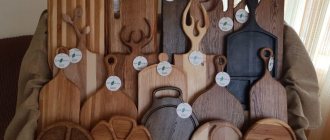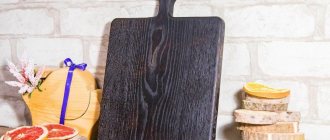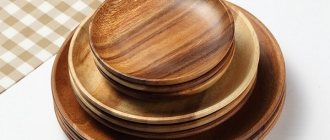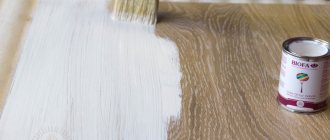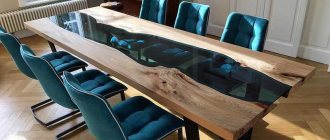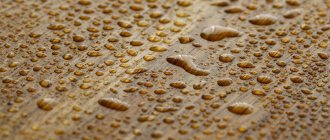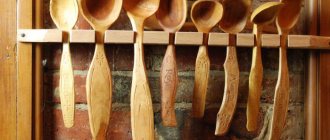Wooden utensils, cutting boards and countertops are work surfaces with maximum mechanical stress. It is difficult to imagine more difficult conditions for coverage. In addition, increased environmental requirements are imposed on dishes and boards. Oils for processing wooden utensils and cutting boards should not contain artificial solvents or components harmful to health. Such a coating should not react with water or hot objects, and at the same time it should have increased dirt and water repellent properties. In other words, not every oil can cope with this task. Therefore, the price of such oil is at a high level.
The old fashioned way: edible flaxseed oil from the store
Many crafters use a homemade mixture of raw linseed oil, beeswax and rosin. What could be more environmentally friendly? Indeed, if we mix all these ingredients and heat them up, we get a simple oil-wax mixture made from natural ingredients. But it’s a stretch to call such a coating harmless to health. The thing is that edible (raw) flaxseed oil, which we are used to seasoning salads with, is healthy only when fresh from the refrigerator. This oil should be stored with the lid tightly closed, excluding air access. The peculiarity of linseed oil is its very rapid ability to oxidize under the influence of oxygen. As a result of oxidation, many free radicals are formed in the oil, which have an extremely negative effect on the entire body. Add to all this the inability of edible flaxseed oil to polymerize (completely dry/harden) and we get an “excellent” cocktail of carcinogens that will enter your body the first time you eat food from dishes or cutting boards treated in this way. It is the inability of the oil to harden inside the wood to form a solid polymer that causes it to enter the body with each use. In general, this is exactly the case when you don’t need to save on your own health and the health of your loved ones. Treating wooden utensils and cutting boards with edible linseed oil is hazardous to health.
Why is processing needed?
During daily cooking, the cutting board is subjected to serious stress. It is regularly scratched with a knife or a kitchen hammer; moisture, juices from vegetables and fruits penetrate into the pores of the material, and dish soap may not be completely washed out of them. The average period of use of wooden utensils is about a year, after which they lose functionality and attractiveness.
Special treatment of the cutting board with oil compounds allows you to fill the pores of the wood and prevent wetting, swelling, and deformation of the product. Impregnation also has the following purposes:
- preventing the absorption of unpleasant odors by wood,
- prevention of cracks, chips and other defects,
- preventing the colonization of the material by harmful microorganisms,
- preventing rotting and microbial toxins from entering food.
With periodic use of impregnation, the service life of the cutting board increases, which will seriously save money, because such products are not cheap. Primary processing should be done immediately after purchasing the utensils, while they have not yet been used in cooking.
It is important not to wash the product before soaking, because oils can “lock” remaining moisture inside the wood fibers. To really extend the life of the board, it must be treated regularly.
Mineral/Vaseline oil
Mineral oil or petroleum jelly is a petroleum product. If we omit all the details about the origin of this type of oil, then the main disadvantage of such impregnation of wooden utensils and boards is the complete lack of ability, along with edible flaxseed, to harden. To put it simply, these types of oils are always in a liquid state inside the wood. The deceptive feeling of a dried surface appears because there is simply no oil on the surface. For this reason, dishes and boards treated in this way must be frequently renewed, since the old coating is very quickly washed away and eaten with food. The degree of harm caused to the body can be discussed forever, but the fact remains a fact. In any case, such a coating cannot be called environmentally friendly and harmless. The main difference between processing with mineral oil and edible linseed oil is that mineral oil has no foreign odors and it does not deteriorate inside the wood. In all other respects, with regard to the protective properties, they are close to zero; such a coating provides only a decorative effect.
Treating the board with oil
First of all, the board must be inspected to understand how the wood fibers are arranged. Impregnation must be applied along the fibers.
We recommend: Gift ideas for February 14: emotional gifts and original little things that won’t be sad on the shelf
Based on their structure, wooden products are divided into several categories:
- Made from cross cuts of wood. This end board is easily recognized by its pattern, reminiscent of growth rings on a stump. End boards are heavier and stronger, and their price is usually higher than other varieties.
- Boards made from longitudinal cuts are called side boards. They are lighter and cheaper than end ones. On them, the fibers form parallel lines running across the movements of the knife during operation.
- Set products, or Butcher Blocks. They are glued together from small blocks made from end grain wood.
Having decided on the type of product, select the appropriate impregnation. These are either mineral or vegetable oils.
Vegetable oils
Traditionally, all peoples used oils obtained from plants to process wood:
- olive,
- sunflower,
- flaxseed,
- sesame,
- grape seeds, etc.
However, today vegetable oils cannot be called ideal for processing cutting boards. They have two significant disadvantages:
- Vegetable oil will go rancid over time. Butyric acid bacteria, eating the nutrients in the oil, produce butyric acid, a substance with an unpleasant odor and bitter taste. Therefore, over time, a product impregnated with a natural composition will begin to smell unpleasant.
- Long drying time. Within 2–3 days, the treated board will stain everything it comes into contact with. Considering that the impregnation is applied in 3–5 layers, the processing process will last for several weeks.
If you definitely want to use vegetable oil, choose flaxseed oil. It practically does not deteriorate.
Another type of impregnation is drying oil. This is vegetable oil cooked with special additives that speed up drying. But even it takes a very long time to dry.
Mineral oils
Petroleum products are becoming an alternative to vegetable oils. They are called mineral oils. Not all mineral impregnations are suitable for treating kitchen utensils. It is worth choosing either special liquids for treating cutting boards (for example, this composition is sold at IKEA) or Vaseline oil. The last option is the most accessible - it can be bought at any pharmacy.
We recommend: How to quickly clean squid after freezing?
To give the oil the optimal consistency, it is mixed with natural beeswax. The base is heated in a water bath, and then small (cherry-sized) pieces of wax are added. The mixture is stirred until homogeneous.
The optimal ratio of oil and wax is 4:1.
The prepared mixture is cooled to room temperature. Now everything is ready to go.
Checking protective properties
To correctly determine the quality of the oil, you need to understand what requirements we place on it. What coating properties are indicators of a quality product?
- The oil should completely polymerize (harden) within a month
- Polymerized oil should not dissolve in water, including in contact with detergents
- When in contact with hot objects, the polymer should not change its properties.
- Polymerized oil should not have any foreign odors
The right oil (oil-wax mixture) inside the wood turns into a solid polymer. This usually takes 20 to 30 days for natural oils. During the polymerization process, all volatile components, including odor, evaporate from the oil. Oil changes from liquid to solid. The polymer obtained as a result of drying the oil becomes inert, namely, it does not enter into any chemical reactions: it does not dissolve in water, is not washed out during use and is not transported into food products, while reliably protecting the wood from the inside.
It is quite easy to check these properties. Take a regular brush and dip it in oil, then place the oiled brush on the windowsill and leave it for about 1 month. After a month, try washing the brush in warm soapy water. If the polymer has not dissolved, then this means that you have high-quality oil.
How to treat a wooden cutting board?
When choosing a finish, the vast majority of craftsmen give preference to compositions made from natural ingredients, primarily oils. There are many options for how to impregnate a new board, but practice shows that the most effective solution in this matter is to use Vaseline oil, which is not difficult to find in a pharmacy.
An alternative to petroleum jelly can be vegetable analogues, in particular nut or flaxseed oil. But, despite the environmental friendliness and simplicity of such finishing, over time it can transmit an unpleasant rancid odor to food that comes into contact with a wooden board. When covering the product with linseed, Vaseline or any other oil, you will have to periodically renew the impregnation, which will wear out as the board is used.
Modern natural compositions based on vegetable oils and waxes
Such compositions do not contain artificial solvents, completely polymerize within a month, and have a certificate of contact of the finished surface with food. The treated, dried surface is completely safe for people, animals and plants.
Thanks to long-term vacuum boiling of various vegetable oils and waxes, the finished oil-wax composition acquires high protective characteristics and the ability to quickly polymerize.
Turning a cutting board into an eye-catching decor
Inspired by the ideas in our gallery, you can create a product that will turn from ordinary household utensils into original decor for your kitchen. Such an expressive and functional piece of furniture will be a spectacular gift that no housewife will remain indifferent to.
join the discussion
Share with your friends
Almost every kitchen has a cutting board, and more than one. In order for a culinary attribute to serve for a long time, it needs care, and this does not only mean timely washing and drying. To process boards you need to purchase oil - regular impregnation guarantees their durability, strength and never-ending quality.
Only special oils are suitable for processing products: olive and sunflower will not do any good.
In the same way, vinegar, soda and other disinfectants (they have their own function) will not be useful for wood.
Azure for wood
Martyanov wood glaze does not contain waxes, thanks to which it penetrates as deeply as possible even into the hardest fibers of wood, providing reliable protection for the inner layers of wood. In addition, glaze significantly saves expensive finishing oil, the consumption of which is reduced by 2.5 times.
On particularly hard wood, it is recommended to apply 2-3 layers of glaze, leaving each layer for 40-60 minutes until the excess is removed. Remove excess oil from the surface as thoroughly as possible, without leaving a film. In this case, interlayer drying should be at least 24 hours until the previous layer is completely dry before applying the next one. The more time passed between coats, the better. Determining the number of layers of glaze required is very simple: they need to be done until the next layer stops being absorbed after an hour. If you applied another layer of glaze, left it for an hour and after an hour it was practically not absorbed, then the wood has already absorbed the required amount of oil. The number of layers required depends on the absorbency of the particular wood.
How to properly impregnate
The product can be processed without much effort. Step-by-step instruction:
- The new board is covered with 3 layers. After each opening, wait until it is completely absorbed.
- Dry in a room with good ventilation.
- The old device must be sanded with sandpaper before processing.
- Dry from moisture.
- Using a napkin, apply the composition over the entire area and sides.
- Leave for 20 minutes.
- Wipe off the remains.
- Repeat after 12 hours.
- The procedure is done three times.
Vaseline and wax coating method:
- Heat the Vaseline composition.
- Place pieces of natural wax in it; there should be 4 times more Vaseline.
- Cool the mixture.
- Apply with a napkin.
Oil for countertops and work surfaces
Unlike glaze, oil for countertops and work surfaces is thicker due to the high content of solid plant waxes and resins. It is also not able to absorb well, but at the same time it is highly wear-resistant, reliably sealing the lower layers.
Wooden utensils or cutting boards treated with glaze and countertop oil, after complete polymerization, acquire 100% hydrophobicity, as well as high dirt and water repellent properties, are not afraid of high temperatures and do not enter into chemical reactions with food.
Are other finishing compounds hazardous to health?
This question still causes heated debate, despite the fact that clear and authoritative answers have long been given to it. To finish wood products in contact with food, you can use any finishing compositions, including oil-based, polyurethane and nitrocellulose varnishes, shellac coatings and linseed oil. These materials are completely harmless to health, but only after complete drying. This is a very important point!
Before you start using any kitchen board that you decide to paint with one of these compounds, you need to make sure that the coating is completely cured. Remember that the presence of a surface film does not mean that the composition has completely dried inside the wood.
Care instructions
In order for a wooden tabletop to retain its appearance longer, it is necessary to properly care for it:
- The wood is wiped with mineral oil. It adds shine and prevents the growth of harmful microbes.
- Every day, remove any remaining water and food, first with a damp sponge, then wipe dry. To clean the countertop and wash dishes, use different sponges and rags.
- Hot dishes, iron containers with sharp edges at the bottom, heavy kitchen appliances are placed on stands.
Oil, wax or varnish
In order for a wooden tabletop to serve for a long time while maintaining an attractive appearance, it is covered with a protective layer. It saves it from moisture, aggressive detergents, extends its service life, and saturates the natural color.
Interesting! A popular color is Venetian oak.
Manufacturers of kitchen sets and woodworkers know how to process a wooden countertop in the kitchen. Three options are recommended: varnish, oil, wax.
Advantages of varnish coating:
- The wood pattern and rich color are better visible;
- several layers prevent surface destruction;
- protection from moisture;
- durability.
The varnish treatment is suitable for both the kitchen table and the countertop. Experts recommend polyurethane and acrylic varnishes.
When using them, table and tabletop:
- will retain its appearance for a long time;
- will withstand cold and hot dishes on its surface;
- will be reliably protected from contamination.
Oil
Special wood oil creates a water-repellent film on the surface. Oil products are made from plant, mineral and synthetic raw materials.
Depending on the drying process, they are divided into:
- Partially dry. Deeply impregnate the wood. The top layer is removed mechanically.
- Completely dry. A hard layer forms on the surface. It does not wash off with water.
Benefits of oil coating:
- highlights the natural color of wood;
- does not exfoliate;
- completely absorbed and does not flow at high temperatures;
- prevents the formation of fungus;
- does not cause harm to health when in contact with food;
- hides abrasions and minor scratches.
Wax is a good option for coating a wooden surface:
- makes the surface waterproof;
- prevents the appearance of mold and mildew;
- Withstands common kitchen detergents.
Types of impregnation oils
There is a large selection of oils for impregnating wood on the market. They can be divided into two large groups - mineral and natural. Let's take a closer look at them.
Mineral
They gained great popularity not so long ago due to active scientific and technological development. Then it became possible to create mineral oil with the required characteristics. About 50 years ago, transformer oil began to be used for wood processing. Of course, this is not its direct purpose. The result proved the opposite, which brought sales of transformer oil to a new level. With its help, it is possible to prevent putrefaction of the tree, maintaining its original appearance. Undoubtedly, the production of this product violates environmental standards. Therefore, more and more enterprises give preference to natural oils or at least combine them with mineral ones.
Natural
Natural oils appeared much earlier than mineral oils. It took time to realize their advantages in wood processing. The spread of natural oils was hampered by the high cost of raw materials. However, modern production methods solve this issue.
Their key advantage is their plant origin. Natural components and the absence of harmful compounds make natural oil safe for humans. The most common types of natural oils for impregnating wooden products:
- Wood oil. One of the very first products that protect wood from rot, water and termites. Suitable for impregnation of floor and ceiling finishes, wooden furniture, trim and tableware.
- Teak oil. A universal product suitable for impregnating both internal wooden surfaces (floors, ceilings, decor, stairs, railings) and external ones (facades, gazebos, furniture and garden figures). The best choice for oak, beech and other expensive wood species. Ingredients: tung and linseed oils, purified turpentine.
- Tar oil. Has pronounced antiseptic properties. Ingredients: stump resin, turpentine, linseed oil. Turpentine helps to better saturate the material. Flaxseed oil stops the composition inside. Widely used in the courts. It is used to treat the bottoms of boats and piers. Suitable for exterior treatments.
- It is deservedly considered the most inexpensive and effective means of protecting wooden surfaces. Flaxseed oil has a high hydrophobic ability, so it fights dampness well. The particles penetrate into every pore of the material, emphasizing the structure and “preserving” it. Suitable for processing indoor and outdoor structures.
- Tonic oil (toning). This type of oil is produced on the basis of condensed plant lipids, which restore natural grace to the tree and protect it from destruction. It will also be possible to avoid problems such as fading, cracks, and drying out. More suitable for outdoor use, as the composition deeply penetrates the wood, literally repelling dirt.
Adviсe
- To remove the smell of garlic, onions or fish, there are three simple ways: lemon, coarse salt and soda. Rub the surface of the board with something, wait a few minutes, wipe off the residue, rinse and dry the board.
- Always clean the board thoroughly after cutting fish, meat and game.
- While you are not using the board, keep it dry. Without moisture, bacteria die within a few hours. Moisture and liquids of any type should not remain on the surface of the board for a long time. If the board does not have legs and you store it horizontally on the countertop, always make sure that water does not accumulate under the board.
- Do not leave the cutting board near a heat source (stove, radiator) unless adequate insulation is installed. High temperatures are contraindicated for hardwood.
- Do not drill the board, gouge holes, or otherwise damage the surface without refinishing the wood.
- Don't use just one area of the cutting surface. Distribute the work across the board to ensure even wear.
- Do not use a sharpened cleaver - it may split the wood.
- Do not wash knives, forks and other utensils on the cutting board.
Practicality and durability
There are two main requirements for a wooden tabletop: it must be practical and durable.
Advantages of wood:
- Eco-friendly, safe to use and dispose of.
- Natural color enhances any interior.
- Pleasant tactile sensations from warm natural material.
- Ease of making different shapes.
- Never goes out of style.
- Natural wood fits into almost any kitchen style.
Flaws:
- Requires careful care.
- Easily damaged.
- Fire hazardous.
- Expensive.
- Heavy in weight.
The durability of a wooden tabletop depends on the source material and manufacturing method.
Hardwood trees are used. A tabletop made of oak or beech will last a long time. Surfaces made of ash, walnut, birch, and pine are more affordable. Many manufacturers prefer larch - an expensive but durable material.
Its features:
- dense wood;
- resistant to mechanical damage and stress;
- the composition contains gum - a natural antiseptic that protects against mold, mildew, and prevents the process of rotting;
- When temperature changes, it releases and absorbs moisture.
Solid surfaces are subject to curvature. Glued wood, that is, assembled from several plates, is as flexible and elastic as possible.
Practicality is due to resistance to moisture, temperature changes, and strength.
From the table top
A durable and functional cutting board can be made from an old countertop. If the size of the canvas is large enough, you can get a cutting kit. For manufacturing you may need the following materials:
- saw or jigsaw;
- sandpaper;
- mineral oil.
Manufacturing instructions:
- Think over the design of the product and draw or print it on a printer. Trace the contours of the board on the workpiece.
- Use a saw (if the board is rectangular) or a jigsaw (if the shape is arbitrary) to cut out the product. Sand the sides with sandpaper or a rasp.
- Cut or drill a hole for hanging. Sand the inside surface of the hole.
- Treat the sides with mineral oil to protect against moisture.
- Decorate the product by painting, cutting or burning.
The tabletop fragment selected for manufacturing must be intact, without chips, cracks or loose areas.
Kitchen board options
The Taste cutting board is made from a single piece of teak wood in a dark brown, almost chocolate color. Smooth structure, rich color, pleasant to the touch curves, smooth lines - all this makes it an elegant accessory that will give the kitchen a special charm.
The Rhombus cutting board stands out from others thanks to its stylish carving, stylized as symmetrical diamonds. The corrugated surface prevents food from sliding on the work surface and greatly simplifies the cooking process.
